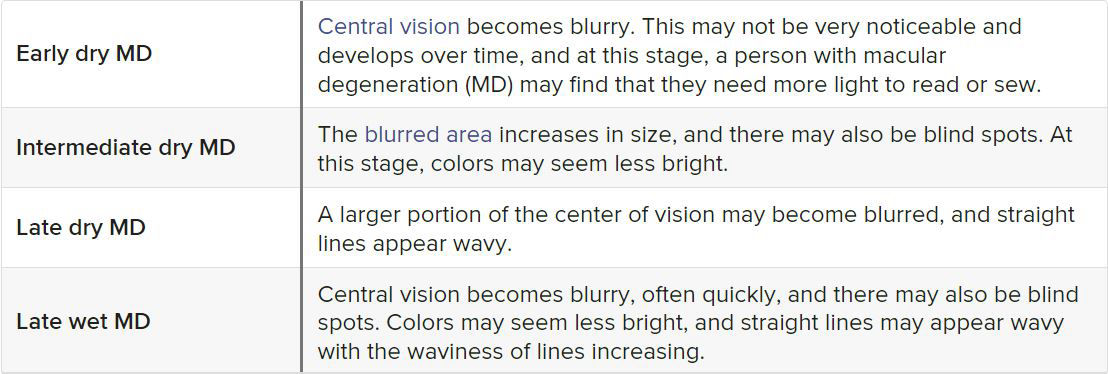
There are two types of macular degeneration: wet and dry.
Macular degeneration is a progressive disease, which means that it will worsen over time. It does not cause physical pain or alter the appearance of the eyes.
Read on to learn more about changes in vision related to macular degeneration, including symptoms, differences between wet and dry types, and when to contact a doctor.

Macular degeneration affects the middle part of a person’s vision. It does not affect the edges of vision, also called peripheral vision.
Initially, a person with macular degeneration may not notice any changes in their vision. However, common changes in vision, which usually progress over several years, include:
● Blurred or distorted vision: This is usually in the middle part of the vision and can make details difficult to see.
● Metamorphopsia: This makes straight lines appear wavy or crooked.
● Blind spots: These are usually in the middle part of the vision. They can become large and make tasks such as reading difficult or impossible.
● Objects looking smaller than usual: This is due to changes in the macula.
● Colors seeming less bright: This occurs when the cones in the eye, which are responsible for color vision, are weakened.
● Poor low light vision: A person with MD may benefit from additional lighting.
Additionally, a person with macular degeneration may have hallucinations and see things that are not there. This is known as Charles Bonnet syndrome (CBS). The images are often common, pleasant images of people or things.
However, this is more common in advanced blindness caused by macular degeneration or other retinopathies. Without visual data coming in through the eyes, the brain fills a void and makes up images or recalls stores images for a person to see. This is what causes the visual hallucinations of CBS.
Learn more about hallucinations and dementia.
Macular degeneration affects both distance and near vision as both involve the central cones in the macula. The common symptoms of blurring and blind spots, for example, affect both distance and near vision.
Low vision means that even with glasses or contact lenses, vision loss makes it difficult to do everyday tasks. This includes detailed tasks requiring near vision, such as sewing, and tasks requiring distance vision, such as driving.
Learn about age-related macular degeneration.
The rate at which macular degeneration progresses can vary from person to person. Additionally, macular degeneration can affect one or both eyes. This will determine to what extent a person’s vision is affected.
The changes in vision associated with macular degeneration vary depending on whether a person has a dry or wet type.
Dry macular degeneration, which accounts for around 90% of people with the condition, develops gradually. Wet MD tends to develop more quickly and greatly affects a person’s vision.
Learn whether macular degeneration causes blindness.
Macular degeneration can affect people in different ways. The changes in vision associated with wet and dry types depend on the stage and progression of the condition.
The table below summarizes the possible changes in vision at each stage.

Someone experiencing sudden vision changes should contact an optometrist or doctor for assessment. Warning signs of MD might include:
● having difficulty reading, even with glasses
● straight lines looking wavy or distorted
● vision not being as clear as it used to be
There is no cure for macular degeneration. However, early diagnosis and treatment may help slow the progression.
Sometimes, a routine eye test may detect MD before a person experiences any noticeable symptoms. If an eye doctor identifies macular degeneration, they will likely do further tests to determine its progression.
Macular degeneration affects a tiny part of the retina at the back of the eye called the macula. These changes affect the central part of a person’s vision.
The type and stage of macular degeneration will determine a person’s vision. Some of the most widespread changes in vision are a blurred or distorted area of vision, blind spots, and straight lines looking wavy or crooked.
Early diagnosis and treatment may help slow the progression.
Published in MedicalNewsToday
Medically reviewed by Grace Zhang, MD — By Jen Colwell on February 27, 2023
Disclaimer: Envy Eye Care's website offers information about vision services and treatment for informational purposes only. Content herein is not intended as medical advice. If you need to speak with an eye doctor in the Dallas area, please contact our office at 469-490-ENVY (3689) to schedule a consultation. This website and blogs are for informational use only. The content within these pages should not perceived as formal advice, nor does the understanding constitute a formal relationship.
Offline Website Maker